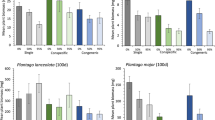Abstract
In indeterminate plant species, the rate of vegetative growth usually declines during the stage of active reproductive growth. Fruit shedding, as induced by insect herbivores, could counteract this decline. Due to the relative increase in vegetative growth, plants that have suffered reproductive damage could be better able to intercept light and acquire soil resources than undamaged plants. If so, plants with damaged neighbours might grow less than their counterparts with smaller, undamaged neighbours. This hypothesis was tested in high- and low-density cotton crops subjected to three treatments: (i) undamaged controls; (ii) uniformly damaged, in which all plants were damaged; (iii) non-uniformly damaged, in which every second plant was damaged. Damaged plants had their flowerbuds and young fruits manually removed at 85 days after sowing to simulate shedding as induced by Helicoverpa spp. (Lepidoptera) and mirid bugs (Hemiptera). As expected, damaged plants had greater leaf area and more vegetative dry matter than undamaged ones. This was most pronounced at high plant density. Neighbour status did not affect vegetative growth but it had a substantial, asymmetric effect on the reproductive growth of target plants. Damaged targets recovered to the level of undamaged controls in terms of total fruit number but had a large reduction in the mass of mature fruit due to the limited time available for recovery. The effect of neighbour status, if any, on the production of mature fruit in damaged targets was overridden by the limit imposed to recovery by the duration of the growing season. In contrast, neighbour status affected the production of mature fruit of undamaged targets: undamaged targets with damaged neighbours had 34% (low density) and 56% (high density) less mature fruit mass than their counterparts with undamaged neighbours. This was because (i) reproductive allocation and (ii) the proportion of total fruit that reached maturity in target plants declined with increasing neighbour interference. Most studies dealing with changes in competitive relationships among plants subjected to differential herbivory have shown how undamaged plants may benefit from herbivores that feed on their neighbours. This study shows that differential reproductive damage can cause the opposite effect, as undamaged plants may have a significant reduction in productivity due to the influence of neighbours whose vegetative growth was stimulated by the loss of reproductive organs.
Similar content being viewed by others
Author information
Authors and Affiliations
Additional information
Received: 2 June 1996 / Accepted: 8 September 1996
Rights and permissions
About this article
Cite this article
Sadras, V. Interference among cotton neighbours after differential reproductive damage. Oecologia 109, 427–432 (1997). https://doi.org/10.1007/s004420050102
Issue Date:
DOI: https://doi.org/10.1007/s004420050102




